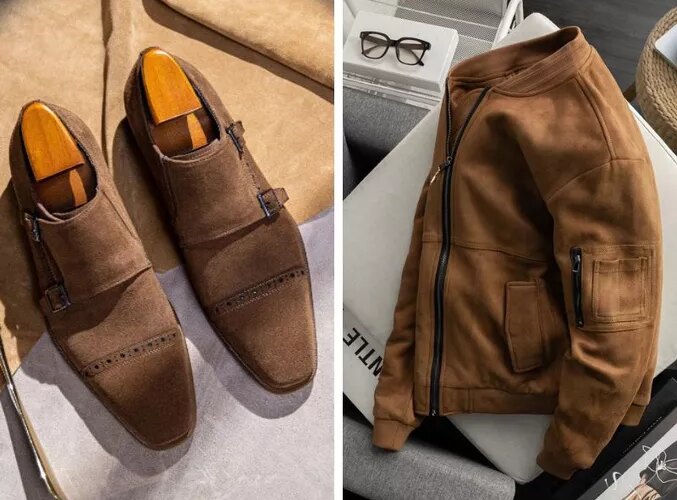Suede fabric is renowned for its luxury, class, and beauty – a popular material for leather goods and unique designs. Let’s delve into its preservation and everyday use.
What is suede?
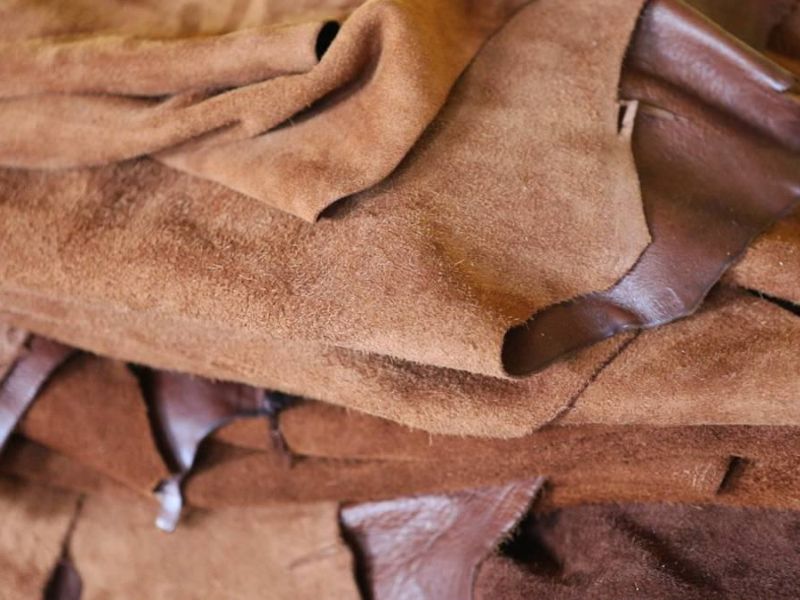
Suede is a type of fabric that is created from the underside of the animal skin, typically from the skin of cows, pigs, or goats. It has a soft, smooth texture and a velvety appearance. Suede is made by sanding or buffing the inner layer of the skin to create a fuzzy nap. This process gives the fabric its unique look and feel. Suede is commonly used in the manufacturing of clothing, shoes, and accessories, as well as in upholstery and home decor items. It is known for its luxurious and elegant appearance, making it a popular choice for high-end fashion and interior design.
Suede is a type of fabric that is created from the outer layer of animal skin, typically sourced from sheepskin, goatskin, or cowhide. It is known for its distinctive softness and excellent stretchability.
The process of making suede fabric typically involves removing the outer skin of an animal and then subjecting it to special processing techniques to achieve a smooth and soft surface. Suede fabric is commonly utilized in the production of various products such as pants, men’s shirts, handbags, shoes, gloves, and other fashion items.
Due to its inherent qualities, suede is highly valued for its exquisite appearance, refined charm, and luxurious texture. However, in order to preserve its longevity and retain its alluring qualities, suede necessitates meticulous and specific care and maintenance.
The origin and process of making suede fabric explained.
The origin of suede
In the past, suede was a highly sought-after material among the upper-class gentlemen and fashionable socialites in France. Its popularity began to rise in the 19th century when soft gloves made of suede were imported from Sweden. These gloves, known as ‘gants de Suède’ or Swedish suede gloves, quickly became a major fashion trend, capturing the attention of the French elite.
During the 1960s, suede emerged as a prominent material within the fashion industry, boasting a wide array of diverse designs. Since then, suede has captured not only the interest of the elite but has also gained widespread popularity across society, finding extensive use in various fields and classes. Presently, suede is utilized in the production of numerous items, including jackets, shoes, and other designs, enhancing the overall luxury and fashion appeal for its users.
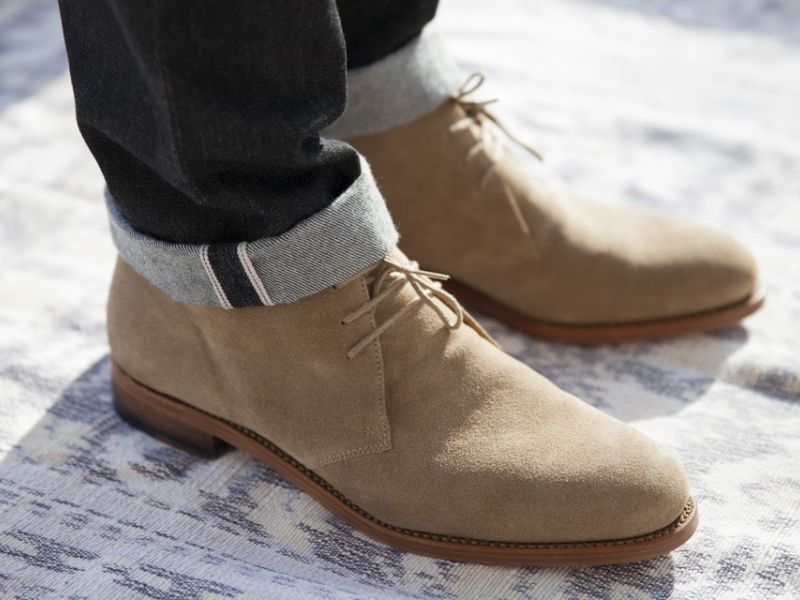
In today’s modern era, suede has become an extensively utilized material in various aspects of life. From fashion and accessories to interior design and upholstery, suede has gained significant popularity and widespread usage.
The production of suede fabric involves a specific manufacturing process.
- Select ingredients: The process of making suede fabric begins with the selection and preparation of the raw material, which is the outer skin of the animal. Sheepskin, goatskin and cowhide are commonly used because of their good properties for making suede fabric.
- Cleaning treatment: The outer skin is harvested from animals through leather harvesting processes, then processed to remove hair, impurities, and dead skin cells. This process includes many steps such as depilation, cleaning, and creating a smooth surface.
- Soften: After cleaning, the leather is put through a softening process using chemical or mechanical agents. The goal of this process is to make the leather soft and pliable for easy shaping and shaping.
- Creating suede fabric: Once the leather has been softened, it is put through conversion steps to create suede fabric. This usually involves using machines or manual processes to sand or buff the leather to create a smooth, soft suede surface.
- Coating and finishing:Finally, once the desired suede surface is achieved, suede can be painted or finished with other materials to enhance its appearance and durability.
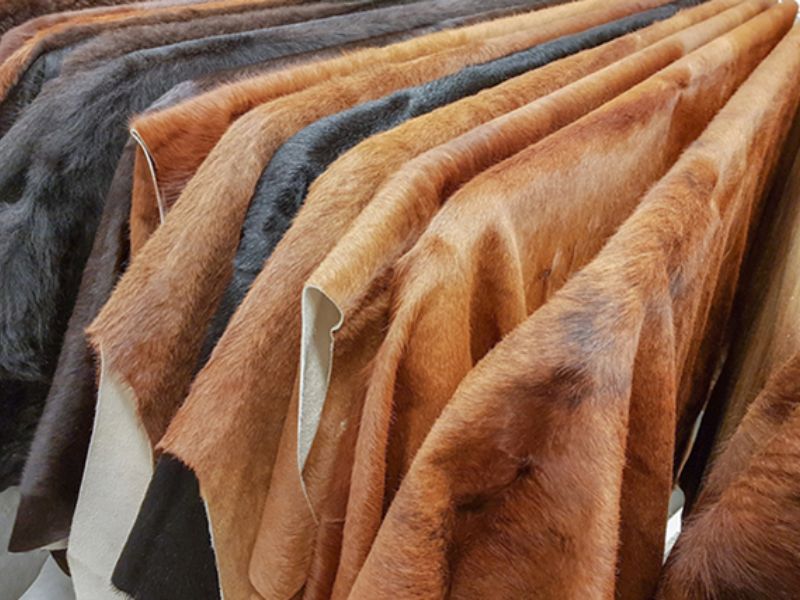
Cowhide, a type of leather derived from the skin of cows, is highly favored and widely sought-after in today’s market. It stands out as one of the most popular choices among consumers and is renowned for its durability, versatility, and distinct texture. Due to these qualities, cowhide has gained significant popularity in various industries such as fashion, interior design, and furniture production. With its timeless appeal and exceptional quality, cowhide continues to be a preferred option for individuals seeking high-quality leather products.
To produce high-quality suede fabric that meets beauty and durability standards, the process necessitates a high level of professionalism and technical expertise. Skilled individuals employ specific techniques to ensure that the suede fabric is crafted with utmost precision and excellence.
Pros and cons of suede.
Advantage
Suede fabric is highly favored in the fashion and leather goods manufacturing industry due to its numerous exceptional qualities. Its popularity stems from the various advantages it offers. Here are some of the key advantages of suede fabric:
1. Luxurious Texture: Suede boasts a soft and velvety texture that exudes a sense of luxury. This unique texture adds a touch of sophistication to any fashion or leather goods item.
2. Rich Appearance: The natural, matte finish of suede fabric gives it a rich, elegant look. Its appearance is highly prized in high-end fashion and leather goods, as it emanates a sense of high quality and craftsmanship.
3. Versatility: Suede fabric is incredibly versatile, making it suitable for a wide range of applications. It can be used in fashion clothing, footwear, handbags, accessories, and upholstery. This versatility adds to its appeal and popularity.
4. Durability: Despite its softness, suede fabric is surprisingly durable. It is resistant to wear and tear and can withstand daily usage, making it a reliable choice for long-lasting fashion and leather goods.
5. Breathability: Suede has excellent breathability, allowing air circulation and preventing moisture build-up. This feature adds to the comfort of wearing suede garments or using suede accessories.
6. Water Resistance: While not completely waterproof, suede fabric has inherent water-resistant properties. It can resist light moisture and drizzle, making it suitable for various weather conditions.
7. Aesthetics: Suede fabric offers a distinctive aesthetic appeal. Its unique texture and rich colors give it a luxurious and fashionable vibe, making it a sought-after choice for designers and consumers alike.
8. Easy to Work with: Suede fabric is relatively easy to work with during manufacturing processes. It can be easily cut, sewn, and styled, making it convenient for designers to create intricate and detailed designs.
9. Comfort: With its soft and plush feel, suede fabric provides exceptional comfort. It is gentle on the skin and offers a cozy and snug sensation, making it pleasant to wear or use in various fashion and leather goods.
Overall, suede fabric stands out in the world of fashion and leather goods manufacturing due to its luxurious texture, rich appearance, versatility, durability, breathability, water resistance, unique aesthetics, ease of use, and comfort. Its numerous advantages make it a preferred choice for those seeking both style and functionality in their products.
- Soft and smooth: Suede has a soft surface that feels comfortable and smooth to the touch. This makes suede products, such as shoes and bags, very pleasant to use.
- High aesthetics: The suede surface of the leather has a natural and luxurious beauty. The suede structure creates embossed patterns, creating an interesting highlight for the product.
- Durable and high strength: Despite its softness, suede is still very durable. It is resistant to abrasion and tearing, allowing suede products to maintain their shape and durability over time.
- Flexible adaptation: Suede lends itself well to a wide range of designs and styles, from fashion to furniture. This creates a lot of flexibility for designers and end users.
- Less water absorbent: Although not completely water-resistant, suede is capable of withstanding small amounts of rain or splashes, making it a popular choice for everyday shoes and bags.
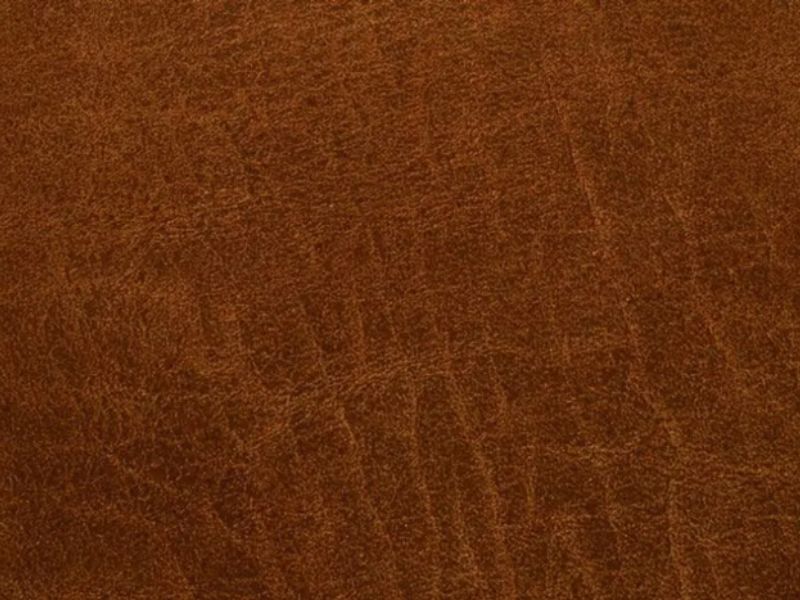
The unique suede surface is achieved by the natural embossed grain, which adds texture and depth to the material.
Defect
Despite its many advantages, suede also has a few drawbacks that should be taken into consideration:
1. Vulnerability to stains and water damage: Suede is known for its porous nature, making it prone to staining and water spots. This can be particularly problematic in wet or dirty environments.
2. Difficulty in cleaning: Cleaning suede can be a tedious and challenging process. Specialized suede cleaning products and techniques are often necessary to effectively remove stains and restore the material’s appearance.
3. Sensitivity to abrasion: Suede is relatively delicate compared to other materials, making it susceptible to abrasion and scuff marks. Constant friction or contact with rough surfaces can quickly damage its texture and overall look.
4. Limited color options: While suede comes in a variety of hues, the available color options are often more limited compared to other fabrics. This might limit the ability to find the exact shade or color desired.
5. High maintenance required: Suede requires regular upkeep to maintain its appearance and longevity. This includes brushing to restore its plushness and applying protective sprays to guard against stains and water damage.
It’s important to weigh these disadvantages against the advantages when considering whether or not suede is suitable for a particular purpose or usage.
- Easily soiled and difficult to clean: Suede is more prone to stains and is more difficult to clean than other fabrics. Once stained, cleaning can be quite difficult and requires special care.
- Sensitive to water and humidity: Faded suedeblistering, peeling or discoloration when exposed to water or high humidity.
- Environmentally vulnerable: Suede can deteriorate quickly if exposed to insects or harsh environments. Scratches, water spots or stains can detract from the value and beauty of the product.
- Need special care: Suede needs proper care to maintain its durability and beauty. Using inappropriate care products can damage suede.
- Expensive and not a recycled material: Suede is often more expensive than other common fabrics and is not a recycled material. This can increase production costs and affect the sustainability of the product.
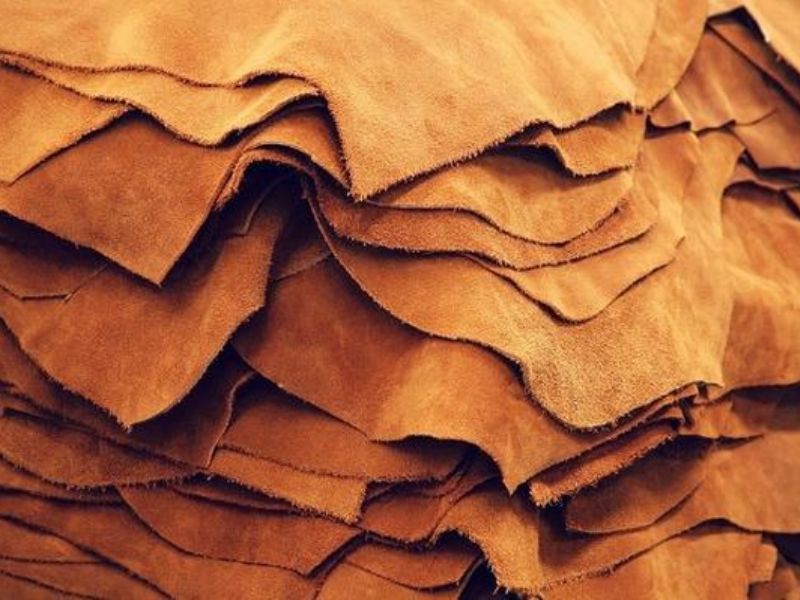
If suede is not given proper care, it can easily be damaged and ruined. This delicate material requires specific maintenance techniques to maintain its appearance and quality. Improper handling or neglect can result in stains, scuffs, and permanent damage, compromising the integrity and beauty of suede items. Therefore, it is crucial to take necessary precautions and follow recommended cleaning and maintenance instructions to preserve the condition of suede and extend its lifespan.
Applications of suede in life
Fashion, leather accessories
Suede is a highly favored material in the fashion industry as it is extensively used to create an array of products including shoes, handbags, wallets, and even men’s jackets. This versatile fabric offers not only a soft and velvety texture but also enhances the overall aesthetic appeal of fashion goods, imparting them with a touch of luxury and individuality.
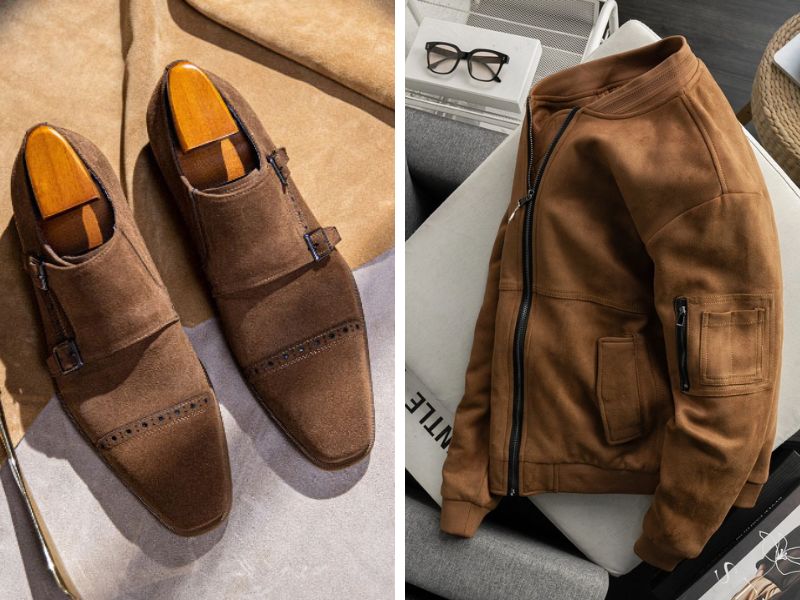
Suede clothing refers to garments made from a type of fabric called suede, which has a soft and velvety texture. Suede is commonly used to create various clothing items such as jackets, skirts, pants, and shoes. It is typically made from the underside of animal leather, making it durable and long-lasting. Suede clothing offers a stylish and luxurious look while providing warmth and comfort to the wearer. Its unique texture adds a touch of elegance to any outfit and makes it a popular choice in fashion.
Suede interior
Suede is widely utilized in the furniture industry to craft sofas, chairs, and desks. The unique softness and smooth texture of suede contribute to creating a comfortable and lavish ambiance in living spaces.
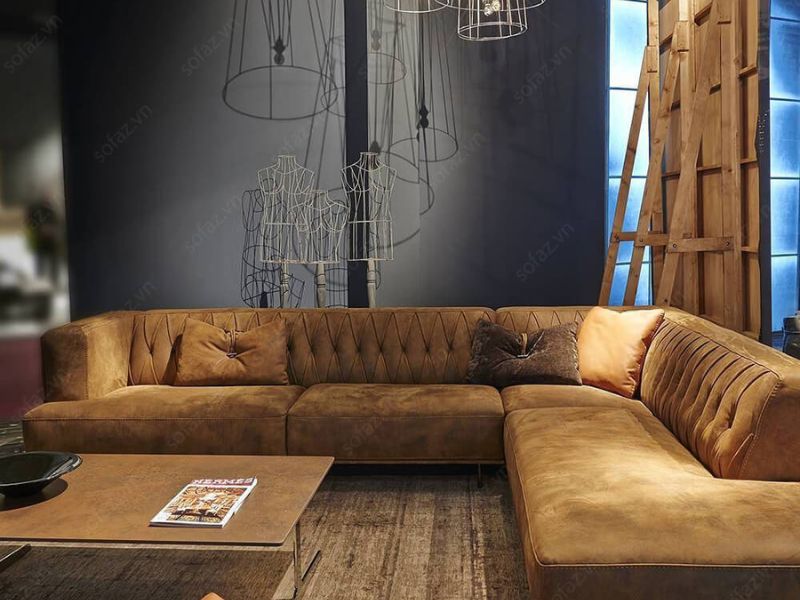
A suede sofa refers to a type of sofa that is upholstered with suede fabric. Suede is a soft and smooth material often made from the underside of animal hides, such as cows, goats, or sheep. The suede fabric lends a luxurious and elegant look to the sofa, with its velvety texture and rich color options. It is a popular choice for those who desire a comfortable and stylish seating option in their living spaces. The suede sofa adds a touch of sophistication and warmth to any room, making it an attractive and inviting piece of furniture.
Leather car interior
Suede is a highly popular material extensively utilized in the automotive industry, particularly for lining armrests and seats. Its widespread use is attributed to the fact that it significantly enhances the driving experience, offering a more authentic, opulent, and plush feel compared to various other materials.
Suede material is known for its ability to offer both comfort and a luxurious aesthetic to the car’s interior. It is commonly found in high-end vehicle models that prioritize superior quality and an enhanced driving experience.
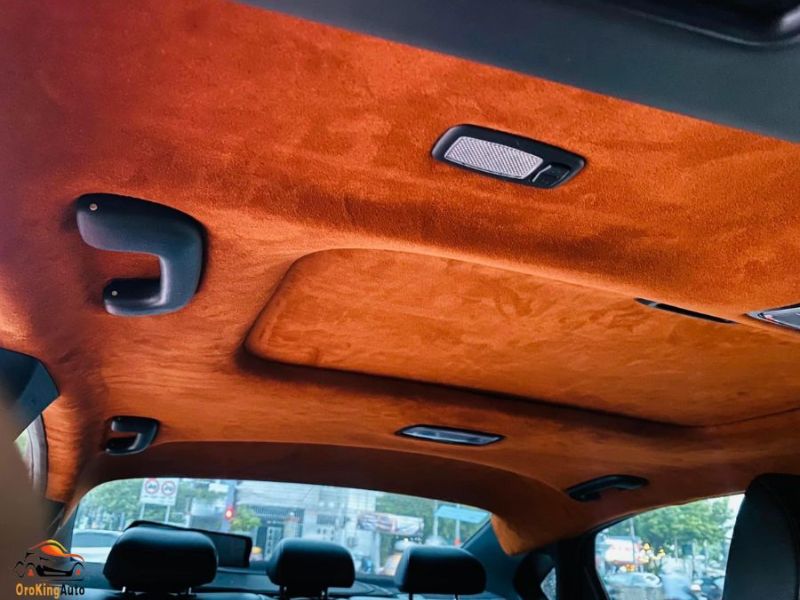
The car’s interior is made of leather, providing a luxurious and high-quality feel. The seats, steering wheel, and other upholstery are all crafted from this material, adding a touch of elegance to the overall design. The leather car interior enhances the aesthetic appeal and comfort of the vehicle, creating a pleasant and sophisticated driving experience.
Tips for preventing suede from fading include keeping it out of direct sunlight and using a suede protector spray.
To prevent any harm, learn how to effectively clean suede without causing any damage.
Suede is a type of material that requires special handling when it comes to cleaning. It is not as simple as tossing it in the washing machine or using regular cleaning methods. To clean suede properly and avoid any damage, it is crucial to follow specific steps:
1. Start by removing any loose dirt or debris from the surface of the suede. You can use a soft brush, like a suede brush or toothbrush, to gently brush off the dirt. Be careful not to rub the material vigorously, as this can cause damage.
2. For small stains or spots, you can use a suede eraser or a clean pencil eraser to gently rub the affected area. Apply light pressure and rub in small circular motions. This can help lift the stain without damaging the suede.
3. For larger stains or more stubborn dirt, you can use a suede cleaner. Make sure to choose a cleaner specifically designed for suede and follow the instructions on the product carefully. Apply the cleaner to a soft cloth or sponge and gently blot the stain. Avoid rubbing or scrubbing vigorously to prevent further damage.
4. After cleaning, allow the suede to dry naturally. Avoid using direct heat or sunlight, as this can cause the material to become stiff or discolored. Instead, place the item in a well-ventilated area and let it air dry. It may take some time for the suede to dry completely, so be patient.
5. Once the suede is dry, use a suede brush to restore its texture and appearance. Brush the suede in one direction to lift the fibers and give it a soft, luxurious feel.
Remember, prevention is better than cure when it comes to suede. Consider using protective sprays or products specifically designed for suede to prevent stains and maintain its quality. Additionally, always check the care instructions provided by the manufacturer before attempting to clean suede items, as some may have specific guidelines.
- Remove dust and dirt: Use a suede brush or soft brush to gently remove dust and dirt from the suede surface. You can do this regularly to prevent dust and dirt from accumulating on the leather.
- Using a damp cloth: For small stains or dirt, you can use a damp cloth to gently wipe the suede surface. Be careful not to use too much water and make sure to dry immediately afterwards to avoid leaving the suede wet for too long.
- Avoid using alcohol: Some people have a habit of drinking alcohol. how to wash suedebut in fact, alcohol can damage the leather texture, causing roughness and burning due to excessive heat. This can cause suede products to become stiff and appear black spots on the surface. Instead, you can use specialized spray products specifically designed for suede, which effectively preserve and clean the product without harming the suede material.
- Using suede care products: There are many special care products designed to clean and preserve suede. Before using, test the product on a small area of the leather to ensure that it does not cause problems such as discoloration or damage to the leather.
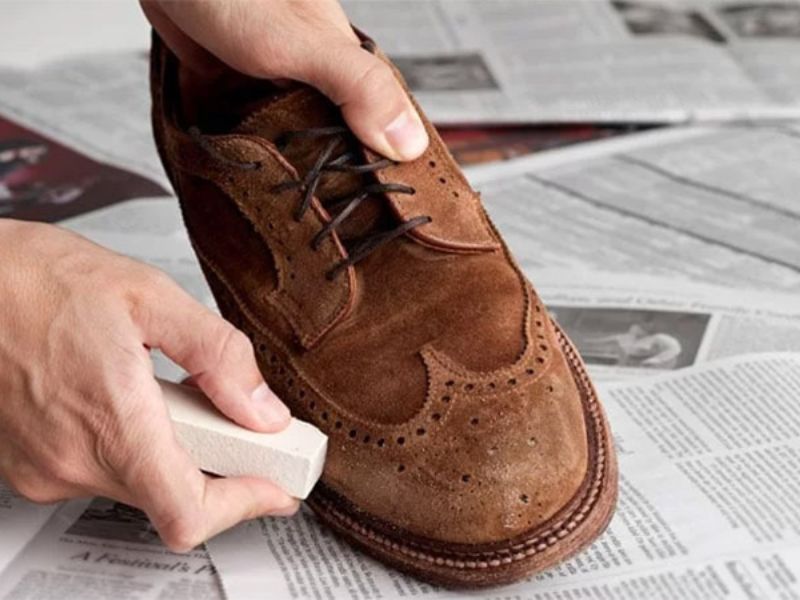
You should use different products specifically designed for caring for suede materials.
To maintain the appearance of suede, follow these tips to preserve its original look for longer.
Maintaining suede requires special attention and care to preserve its delicate texture and natural appearance. By following these essential steps, you can effectively keep your suede items in optimal condition:
1. Protecting from moisture: Suede is highly susceptible to water damage, so it’s crucial to safeguard it from moisture. Apply a protective waterproof spray specifically designed for suede before using the item. This will create a barrier that repels water, preventing stains and damage.
2. Brushing regularly: Use a suede brush or specialized suede eraser to gently remove any dirt or debris from the surface. Ensure you brush in the direction of the suede’s nap, which is the direction of the fibers. Regular brushing helps revive the suede and prevent the accumulation of dirt.
3. Treating stains immediately: In case of spills or stains, it is essential to address them promptly. Blot the affected area gently with a clean, dry cloth to soak up as much liquid as possible. Avoid rubbing the stain vigorously, as this can spread it further. Use a suede eraser or specialized cleaner to treat the stain, following the product’s instructions.
4. Drying properly: If your suede item becomes wet, let it air dry naturally. Avoid using direct heat (such as a hairdryer or heater) as it can damage the material. Stuff the item with clean white paper or a towel to help maintain its shape while it dries.
5. Reviving the nap: Over time, suede may become flattened and lose its texture. To revive the nap, gently brush the surface with a suede brush or rub it with a towel in circular motions. This helps raise the fibers, restoring its soft and velvety feel.
6. Storing correctly: When storing suede items, keep them in a cool, dry place away from direct sunlight. Avoid folding or crushing the suede, as this can cause permanent creases. Consider using a breathable fabric or suede storage bag to protect it from dust and maintain its condition.
By following these detailed steps, you can ensure that your suede items remain in excellent condition, preserving their natural beauty for years to come.
- Store in a cool, dry place: Make sure that suede products are stored in a cool, dry place to prevent mold or moisture build-up.
- Avoid direct sunlight: Sunlight can discolor and dry out suede. Avoid direct sunlight and store in a shaded area.
- Use a container or cloth bag: To protect suede from dirt and external influences, store the product in a clean box or cloth bag.
- Avoid contact with water: Is suede waterproof? Suede does not withstand water well, so avoid exposing the product to water or other liquids.
- Avoid contact with chemicals: Environmental chemicals or other products can damage suede. Avoid direct contact with chemicals such as gasoline, oil or other solvents.
- Routine care: Perform regular cleaning and maintenance to remove dust and dirt from suede surfaces, helping to maintain the natural beauty and durability of the product.
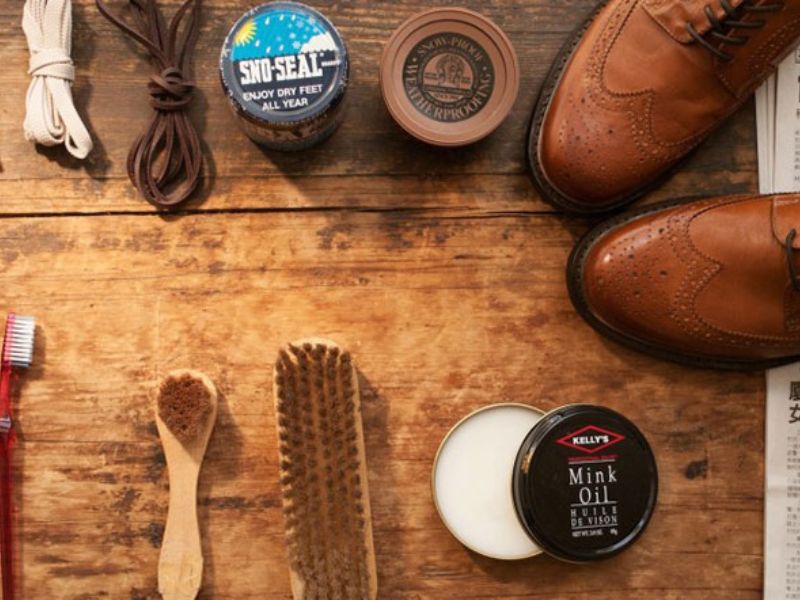
It is recommended to store the item in an area that is cool and dry.
Through this article, readers of Fashion Bandung will hopefully find the answer to the question, “What is suede?” In addition, they will also gain valuable information about suede fabric and learn about its various applications in everyday life.
Fashion Bandung is a fashion brand specifically catering to the style needs of men. We offer a wide range of trendy and fashionable clothing options that are designed to meet the diverse preferences and tastes of our customers. From casual wear to formal attire, our collection has something for every occasion. Our commitment to quality craftsmanship ensures that the garments we offer are not only stylish but also durable and long-lasting. With Fashion Bandung, men can confidently express their personal style through our fashionable clothing options.
>> For additional information, please refer to the following:

